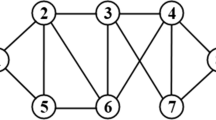Abstract
The derivative problems from the classical shortest path problem (SPP) are becoming more and more important in real life[1]. The dissimilar shortest paths problem is a typical derivative problem. In Vehicles Navigation System(VNS),it is necessary to provide drivers alternative paths to select. Usually, the path selected is a dissimilar path to the jammed path. In fact, ”dissimilar” is fuzzy. Considering traffic and transportation networks in this paper, we put forward to the definition of dissimilar paths measure that takes into account the decision maker’s preference on both the road sections and the intersections. The minimum model is formulated in which not only the length of paths but also the paths dissimilar measure is considered. And a genetic algorithm also is designed. Finally, we calculate and analyze the dissimilar paths in the traffic network of the middle and east districts of Lanzhou city in P.R. of China by the method proposed in this paper.
Preview
Unable to display preview. Download preview PDF.
Similar content being viewed by others
References
Cherkassky, B.V., Goldberg, A.V., Radzik, T.: Shortest paths algorithms:Theory and experimental evaluation. Mathematical programming, 129–174 (1996)
Yen, J.Y.: Finding the k shortest loopless paths in a network. Management Science 17, 721–726 (1971)
Miaou, S.P., Chin, S.M.: Computing k-shortest paths for nuclear spent fuel highway transportation. European Journal of Operational Research 53, 64–80 (1991)
Shier, D.R.: On algorithms for finding the k shortest paths in a network. Networks 17, 341–352 (1979)
Lee, C.K.: A multiple path routing strategy for Vehicle route guidance systems. Tran. Res. 2c, 185–195 (1994)
Dial, R., Glover, F., Karney, D.: A computational analysis of alternative algorithms and labeling techniques for finding shortest path trees. Networks 9, 214–248 (1999)
Lombard, K., Church, R.L.: The gateway shortest path problem:Generating alternative routes for a corridor location problem. Geographical systems 1, 25–45 (1993)
Wang, K., Xu, Y.: A model and algorithm on the path selection in dissimilar path problem. Theory Method Application of system engineering 1, 8–12 (2001)
Kuby, M.: Programming models for facility dispersion: The p-dispersion and Maximum Dispersion Problems. Geographical Analysis 19, 315–329 (1987)
Erkut, E.: The discrete p-dispersion problem. European Journal of operational Research 46, 48–60 (1990)
Ruphail, N.M., et al.: A Dss for dynamic pre-trip route planning. Applications of advanced technologies in transportation engineering. In: Proc of the 4th Intl. Conference, pp. 325–329 (1995)
Yang, Q.: Research on the path selection based on multiple rational paths. Journal of managing Engineering 4, 42–45 (2004)
Gen, M.: Bicriterion network design problem. In: The 3rd International Information and Management Science Conference, Dunhuang, P.R.of China, vol. 5, pp. 419–425 (2004)
Li, Y., He, R.: On the models and algorithms for finding dissimilar shortest paths in a traffic network. In: The 7th National Operation Research Conference of China, Qingdao, China, vol. 8 (2004)
Author information
Authors and Affiliations
Editor information
Editors and Affiliations
Rights and permissions
Copyright information
© 2005 Springer-Verlag Berlin Heidelberg
About this paper
Cite this paper
Li, Y., He, R., Liu, L., Guo, Y. (2005). Genetic Algorithms for Dissimilar Shortest Paths Based on Optimal Fuzzy Dissimilar Measure and Applications. In: Wang, L., Jin, Y. (eds) Fuzzy Systems and Knowledge Discovery. FSKD 2005. Lecture Notes in Computer Science(), vol 3613. Springer, Berlin, Heidelberg. https://doi.org/10.1007/11539506_39
Download citation
DOI: https://doi.org/10.1007/11539506_39
Publisher Name: Springer, Berlin, Heidelberg
Print ISBN: 978-3-540-28312-6
Online ISBN: 978-3-540-31830-9
eBook Packages: Computer ScienceComputer Science (R0)




